The ultimate tennis matches in a year usually occur at the Grand Slams or in Fed and Davis Cup competitions.
At their very best, it’s tough to choose between a match involving the top players in a Wimbledon final or a crucial, pressure-packed Davis Cup situation.
Wimbledon is the ultimate in Grand Slam competition while the Fed and Davis Cups are national team events at their highest level that stir the passions in a unique way.
Ideally, both should flourish and showcase tennis at its finest and most compelling. But practically only the Grand Slams consistently deliver the top players in a setting that allows for maximum exposure on the sports scene.
Canada lost its Fed Cup first round of the eight-nation World Group this weekend, soundly beaten 4-0 by a Czech Republic team that was undeniably better.
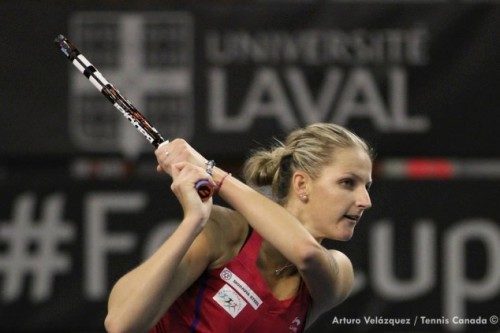

On Sunday, Karolina Pliskova clinched the win at the PEPS arena in Quebec City with a 6-4, 6-2 victory over Gabriela Dabrowski and then Czechs Lucie Hradecka and Denisa Allertova combined for a doubles 6-1, 7-6(2) win in the pro forma fourth and final match.
The caveat on the World Group first rounder was that Canada was without its best player, Genie Bouchard, facing a Czech opponent with enough depth to hardly miss a beat without the two women – Petra Kvitova and Lucie Safarova – who have led it to three Fed Cup titles in the past four years.
Unlike the four Grand Slams where not participating has become virtually unthinkable, Fed and Davis Cup have been lessened over the years by the best players electing not to play – or sometimes not being physically able to play.
In the Canadian context, the team led by captain Sylvain Bruneau this weekend was in World Group - a place among the elite eight nations that actually compete for the Fed Cup – because of two World Group II victories in 2014. First, in February, Canada beat a Serbian team in Montreal that did not have its best three players – Ana Ivanovic, Jelena Jankovic and Bojana Jovanovski.
In April, Canada defeated the Slovaks, again its opponent was diminished with neither Dominka Cibulkova or Daniela Hantuchova taking part.
With Bouchard in full flight and Aleksandra Wozniak playing well, Canada was able to win those two rounds and advance to the World Group.
This past weekend, it was the opposite story, without Bouchard, who chose not to play, and Wozniak, recovering from shoulder surgery, Canada was no match for a Czech team led by the No. 22-ranked Pliskova and No. 62-ranked Tereza Smitkova.
Something similar happened in Davis Cup for Canada in 2013. In the first round played in Vancouver, the Canadians won 3-1 over Spain without any of its top-five players – Rafael Nadal, David Ferrer, Nicolas Almagro, Fernando Verdasco or Feliciano Lopez. It went on to reach the semifinals before losing in Belgrade to Serbia.
But a year later in 2014’s first round, it was Canada with a decimated team – Milos Raonic (lower leg) and Vasek Pospisil (back) were injured and unavailable for captain Martin Laurendeau's team. Canada was ousted 3-1 in the first round of World Group action in Tokyo by a Japanese team led by a healthy Kei Nishikori.
(Incidentally, Canada gets a chance to avenge that defeat in Vancouver from March 6-8 when the two countries meet again in 2015 opening round World Group action.)
Historically, unlike the Grand Slams, Fed and Davis Cup have been, and continue to be, plagued by top players choosing not to play. That has been more evident on the men’s side and probably can be traced back as far as Jimmy Connors and his unwillingness to represent the U.S. in the 1970s.
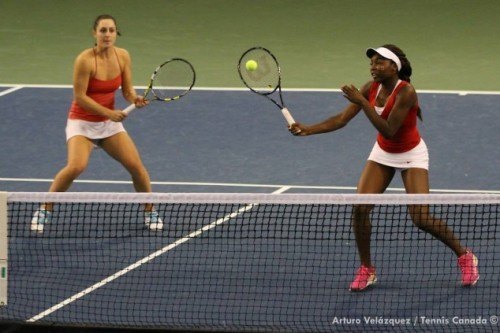

At the moment, aside from national pride, there’s really only one thing that forces players to compete in Fed and Davis Cup. The International Tennis Federation rule for participation in the Olympic Games that requires they make themselves available to compete in Fed and Davis Cup three times in the quadrennial between Games – with one mandatory participation in the final two years leading into the Games.
Several of the very best players played Fed Cup this weekend – Serena and Venus Williams for the U.S. and Maria Sharapova for Russia foremost among them. Who knows for sure whether they really wanted to play or if it was just about meeting their Fed Cup quota to be eligible for next year’s Olympics in Rio de Janeiro?
In the case of Serena and Venus, they had played only once before in the quadrennial, and now need to play just once more – in potentially three or four occasions – before the Rio Games in August 2016.
Sharapova has less room to maneuver – this is her first Fed Cup appearance since the last Olympics, so she needs two more participations to be Olympic eligible in 2016. All three could conceivably come this year if Russia beats Germany at home in the Fed Cup semifinals in April and then plays the final in November.
As for Bouchard, she needs one more Fed Cup appearance, which may be as early as April or possibly not until next year.
Sharon Fichman, the senior member, at 24, of this past weekend’s Canadian Fed Cup team, presumably gave a gist of the squad’s feelings about Canada’s best player when she said about Bouchard’s absence, “we’re disappointed but we do understand how the tennis scheduling works. It’s not easy to come out and make this event happen – as much as we all want to do it. Genie is just as patriotic as the next Canadian, and I can say that firsthand. (There’s) disappointment that we don’t have our number one player but I’m sure that everything that could have been done was done – the decision that was made had reasons for it. And we support her. And we really hope to see her for the next tie in April.”
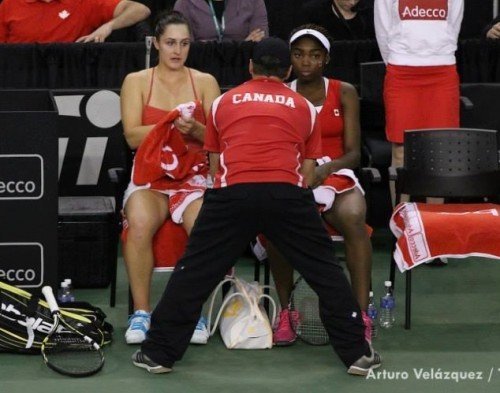

Summing up this weekend’s results, captain Sylvain Bruneau, who remained a true believer in his depleted team’s chance’s right up until the end, said, “I’m very disappointed because I really thought we could push them. To win three matches would have been very difficult, because they have a really good doubles team, but I really thought we’d have a really competitive, really tight tie. But that wasn’t the case.
“We don’t know who will play the next tie, but what is sure is that if you look at the World Group, if you look at the teams that are there with us, they’re all countries with several players in the top-100, or in the top-50 and it’s like that even in World Group II. It’s obvious that if we want to really be competitive, stay there and do things well, we need elements on the team that are of that level because there’s no magic about it…that’s just how it is.”
The only player of that level is current world No. 7 Bouchard, or Wozniak if she could get back to No. 21, her highest career ranking in 2009.
Regarding the delicate matter of top stars committing to Fed Cup, Bruneau said, “I don’t know if there are any possible solutions, I suppose the ITF is looking at it. Maybe you could give (ranking) points…that might help. And look at the format, maybe that too. But it’ll always be difficult to ask players in the top-10 to play two or three Fed Cup ties each year. I’m not sure that we’ll ever be able to get everyone to answer the bell for each one of the ties.”
His Czech counterpart Petr Pala, has been the Czech captain for five years. “It’s a difficult question, I would love it that everyone would play,” he said about the Fed Cup conundrum. “I know I’ve been to many captains meetings thinking about dates, system or how many teams in the World Group. It’s always difficult to find the right solution. I would love to have 16 teams in the World Group because there are so many great countries and great players playing in (World) Group II. And if you had 16 teams, you’d have a shot for the title every year. Let’s say now you have USA playing in the (April) playoffs, Australia playing the playoffs, Italy is going to play in the playoffs – somebody is going to go down even with 16 teams. But I wouldn’t expect those teams to go down.
“Maybe you have (ranking) points. In Davis Cup they have points.
“I would love to see a full squad every time, that’s the challenge to have great players. If you see the trophy, you see the history of this event. And if you don’t have a Grand Slam in your home country, the Fed Cup or Davis Cup ties played at home only make you more popular – playing in front of a good crowd at home.
“It’s not always easy to find the date or the format, I hope they will find it because I like this competition and I can see how much it means to the players. It’s a completely different feeling to play for your country, and a different kind of pressure.”
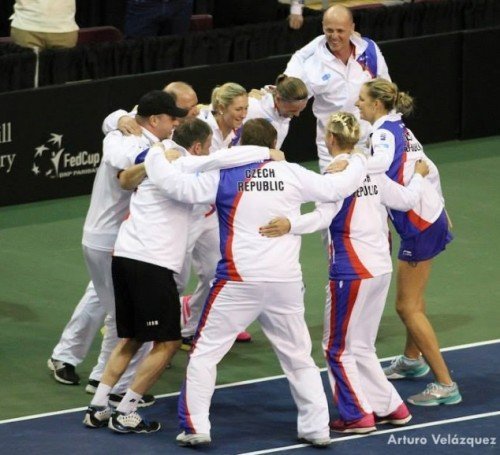

Next for the Czechs will be a semifinal date April 18-19 with France at home.
As for Canada, it awaits a draw at ITF headquarters in London on Tuesday morning to find out which of these countries it will face:
Romania (coin toss)
Netherlands (coin toss)
Switzerland (away)
United States (coin toss)
Obviously Bouchard’s presence would be a huge boost to Canada’s chance of winning in April and maintaining its spot in World Group for 2016.
Tennis Canada senior vice president Eugene Lapierre said his organization was pleased with the weekend, a turn-out of 4,449 for the two days of competition.
He revealed that if Canada is to host a World Group playoff April 18-19, there’s a good chance it would be held at the Maurice Richard Arena in Montreal.
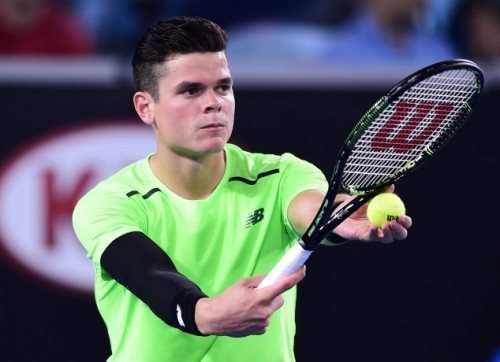 Canada’s top players return to regular tournament action this week with Milos Raonic and Vasek Pospisil playing the ATP 500 event in Rotterdam.
Raonic is seeded No. 2 behind top-seeded Andy Murray and will play Andrey Kuznetsov of Russia (first meeting) in his debut with the winner of Simone Bolelli – Lukas Rosol awaiting in round two. Further down the road it could be either Stan Wawrinka (5) or Grigor Dimitrov in the semifinal and Andy Murray or No. 3 seed Tomas Berdych in the final.
The No. 59-ranked Pospisil has drawn No. 22 Philipp Kohlschreiber (first meeting) in the opening round, and would face either Murray or qualifier Nicolas Mahut in the second.
As for Bouchard, she gets a bye as top seed at the $731,000 (US) Premier event in Antwerp, Belgium, before playing the winner of a qualifier and Mona Barthel. In the quarter-finals, she could potentially play 8th seed Alizé Cornet and in the semifinals either No. 3 Andrea Petkovic or No. 6 Dominka Cibulkova.
In the final, if she is able to get there, she would be seeded to meet No. 2 Angelique Kerber or No. 4 Lucie Safarova, who is slated to encounter her countrywoman, and Fed Cup heroine from this past weekend, No. 8 seed Karolina Pliskova, in the quarter-finals.
Canada’s top players return to regular tournament action this week with Milos Raonic and Vasek Pospisil playing the ATP 500 event in Rotterdam.
Raonic is seeded No. 2 behind top-seeded Andy Murray and will play Andrey Kuznetsov of Russia (first meeting) in his debut with the winner of Simone Bolelli – Lukas Rosol awaiting in round two. Further down the road it could be either Stan Wawrinka (5) or Grigor Dimitrov in the semifinal and Andy Murray or No. 3 seed Tomas Berdych in the final.
The No. 59-ranked Pospisil has drawn No. 22 Philipp Kohlschreiber (first meeting) in the opening round, and would face either Murray or qualifier Nicolas Mahut in the second.
As for Bouchard, she gets a bye as top seed at the $731,000 (US) Premier event in Antwerp, Belgium, before playing the winner of a qualifier and Mona Barthel. In the quarter-finals, she could potentially play 8th seed Alizé Cornet and in the semifinals either No. 3 Andrea Petkovic or No. 6 Dominka Cibulkova.
In the final, if she is able to get there, she would be seeded to meet No. 2 Angelique Kerber or No. 4 Lucie Safarova, who is slated to encounter her countrywoman, and Fed Cup heroine from this past weekend, No. 8 seed Karolina Pliskova, in the quarter-finals.
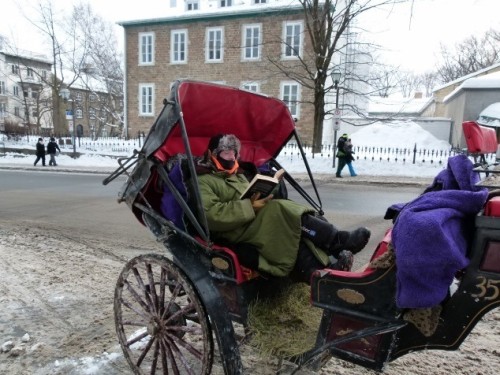 There are down times in the professional life of a ‘caleche’ (horse and buggy) driver in Quebec City. It was at least -17 C when this picture was taken on Sunday morning and the driver casually claimed that what he was doing was “all in a day’s work” despite the frigid temperature. BTW – he was reading a Robert Ludlum novel.
There are down times in the professional life of a ‘caleche’ (horse and buggy) driver in Quebec City. It was at least -17 C when this picture was taken on Sunday morning and the driver casually claimed that what he was doing was “all in a day’s work” despite the frigid temperature. BTW – he was reading a Robert Ludlum novel.
Meanwhile – back to normal programming
 Canada’s top players return to regular tournament action this week with Milos Raonic and Vasek Pospisil playing the ATP 500 event in Rotterdam.
Raonic is seeded No. 2 behind top-seeded Andy Murray and will play Andrey Kuznetsov of Russia (first meeting) in his debut with the winner of Simone Bolelli – Lukas Rosol awaiting in round two. Further down the road it could be either Stan Wawrinka (5) or Grigor Dimitrov in the semifinal and Andy Murray or No. 3 seed Tomas Berdych in the final.
The No. 59-ranked Pospisil has drawn No. 22 Philipp Kohlschreiber (first meeting) in the opening round, and would face either Murray or qualifier Nicolas Mahut in the second.
As for Bouchard, she gets a bye as top seed at the $731,000 (US) Premier event in Antwerp, Belgium, before playing the winner of a qualifier and Mona Barthel. In the quarter-finals, she could potentially play 8th seed Alizé Cornet and in the semifinals either No. 3 Andrea Petkovic or No. 6 Dominka Cibulkova.
In the final, if she is able to get there, she would be seeded to meet No. 2 Angelique Kerber or No. 4 Lucie Safarova, who is slated to encounter her countrywoman, and Fed Cup heroine from this past weekend, No. 8 seed Karolina Pliskova, in the quarter-finals.
Canada’s top players return to regular tournament action this week with Milos Raonic and Vasek Pospisil playing the ATP 500 event in Rotterdam.
Raonic is seeded No. 2 behind top-seeded Andy Murray and will play Andrey Kuznetsov of Russia (first meeting) in his debut with the winner of Simone Bolelli – Lukas Rosol awaiting in round two. Further down the road it could be either Stan Wawrinka (5) or Grigor Dimitrov in the semifinal and Andy Murray or No. 3 seed Tomas Berdych in the final.
The No. 59-ranked Pospisil has drawn No. 22 Philipp Kohlschreiber (first meeting) in the opening round, and would face either Murray or qualifier Nicolas Mahut in the second.
As for Bouchard, she gets a bye as top seed at the $731,000 (US) Premier event in Antwerp, Belgium, before playing the winner of a qualifier and Mona Barthel. In the quarter-finals, she could potentially play 8th seed Alizé Cornet and in the semifinals either No. 3 Andrea Petkovic or No. 6 Dominka Cibulkova.
In the final, if she is able to get there, she would be seeded to meet No. 2 Angelique Kerber or No. 4 Lucie Safarova, who is slated to encounter her countrywoman, and Fed Cup heroine from this past weekend, No. 8 seed Karolina Pliskova, in the quarter-finals.
Quebec City post card
 There are down times in the professional life of a ‘caleche’ (horse and buggy) driver in Quebec City. It was at least -17 C when this picture was taken on Sunday morning and the driver casually claimed that what he was doing was “all in a day’s work” despite the frigid temperature. BTW – he was reading a Robert Ludlum novel.
There are down times in the professional life of a ‘caleche’ (horse and buggy) driver in Quebec City. It was at least -17 C when this picture was taken on Sunday morning and the driver casually claimed that what he was doing was “all in a day’s work” despite the frigid temperature. BTW – he was reading a Robert Ludlum novel.






